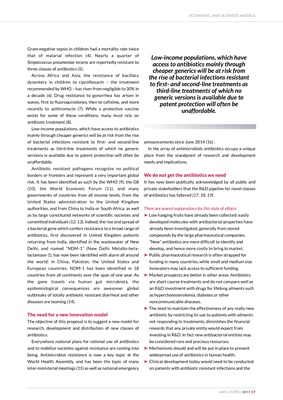
Gram-negative sepsis in children had a mortality rate twice
that of malarial infection (4). Nearly a quarter of
Streptococcus pneumoniae strains are reportedly resistant to
three classes of antibiotics (5).
Across Africa and Asia, the resistance of bacillary
dysentery in children to ciprofloxacin - the treatment
recommended by WHO - has risen from negligible to 30% in
a decade (6). Drug resistance to gonorrhea has arisen in
waves, first to fluoroquinolones, then to cefixime, and more
recently to azithromycin (7). While a protective vaccine
exists for some of these conditions, many must rely on
antibiotic treatment (8).
Low-income populations, which have access to antibiotics
mainly through cheaper generics will be at risk from the rise
of bacterial infections resistant to first- and second-line
treatments as third-line treatments of which no generic
versions is available due to patent protection will often be
unaffordable.
Antibiotic resistant pathogens recognize no political
borders or frontiers and represent a very important global
risk. It has been identified as such by the WHO (9), the G8
(10), the World Economic Forum (11), and many
governments of countries from all income levels, from the
United States administration to the United Kingdom
authorities, and from China to India or South Africa, as well
as by large constituted networks of scientific societies and
committed individuals (12, 13). Indeed, the rise and spread of
a bacterial gene which confers resistance to a broad range of
antibiotics, first discovered in United Kingdom patients
returning from India, identified in the wastewater of New
Delhi, and named "NDM-1" (New Delhi Metallo-betalactamase-1),
has now been identified with alarm all around
the world: in China, Pakistan, the United States and
European countries. NDM-1 has been identified in 18
countries from all continents over the span of one year. As
the gene travels via human gut microbiota, the
epidemiological consequences are awesome: global
outbreaks of totally antibiotic resistant diarrheal and other
diseases are looming (14).
The need for a new innovation model
The objective of this proposal is to suggest a new model for
research, development and distribution of new classes of
antibiotics.
Everywhere national plans for rational use of antibiotics
and to mobilize societies against resistance are coming into
being. Antimicrobial resistance is now a key topic at the
World Health Assembly, and has been the topic of many
inter-ministerial meetings (15) as well as national emergency
announcements since June 2014 (16) .
In the array of antimicrobials antibiotics occupy a unique
place from the standpoint of research and development
needs and implications.
We do not get the antibiotics we need
It has now been publically acknowledged by all public and
private stakeholders that the R&D pipeline for novel classes
of antibiotics has faltered (17, 18, 19).
There are several explanations for this state of affairs:
‰ Low hanging fruits have already been collected: easily
developed molecules with antibacterial properties have
already been investigated, generally from stored
compounds by the large pharmaceutical companies.
"New" antibiotics are more difficult to identify and
develop, and hence more costly to bring to market.
‰ Public pharmaceutical research is often strapped for
funding in many countries, while small and medium size
innovators may lack access to sufficient funding.
‰ Market prospects are better in other areas. Antibiotics
are short course treatments and do not compare well as
an R&D investment with drugs for lifelong ailments such
as hypercholesterolemia, diabetes or other
noncommunicable diseases.
‰ The need to maintain the effectiveness of any really new
antibiotic by restricting its use to patients with ailments
not responding to treatments, diminishes the financial
rewards that any private entity would expect from
investing in R&D. In fact new antibacterial entities may
be considered rare and precious resources.
‰ Mechanisms should and will be put in place to prevent
widespread use of antibiotics in human health.
‰ Clinical development today would need to be conducted
on patients with antibiotic resistant infections and the
ECONOMIC AND BUSINESS MODELS
AMR CONTROL 2015 27
Low-income populations, which have
access to antibiotics mainly through
cheaper generics will be at risk from
the rise of bacterial infections resistant
to first- and second-line treatments as
third-line treatments of which no
generic versions is available due to
patent protection will often be
unaffordable.